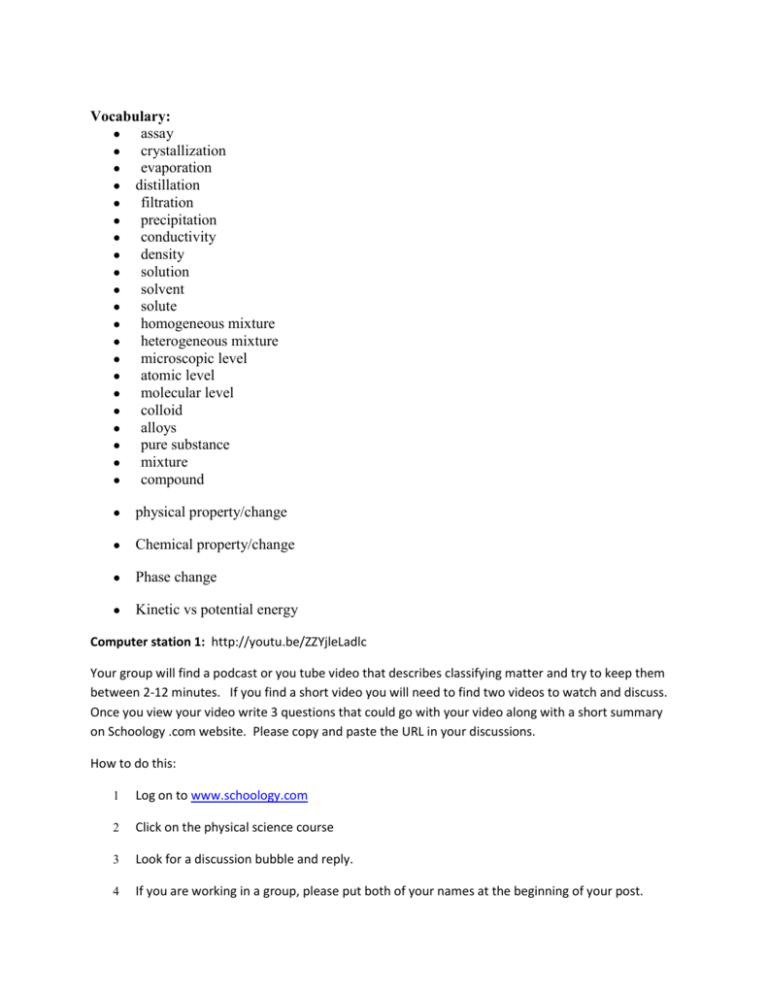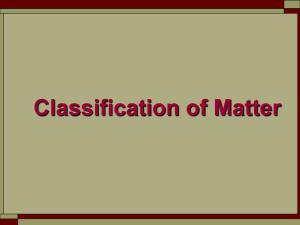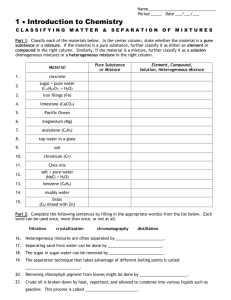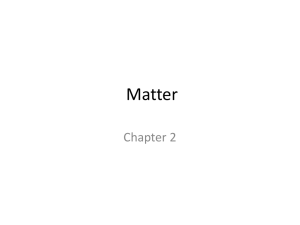psclassifyingmatterlesson
advertisement

Vocabulary: ● assay ● crystallization ● evaporation ● distillation ● filtration ● precipitation ● conductivity ● density ● solution ● solvent ● solute ● homogeneous mixture ● heterogeneous mixture ● microscopic level ● atomic level ● molecular level ● colloid ● alloys ● pure substance ● mixture ● compound ● physical property/change ● Chemical property/change ● Phase change ● Kinetic vs potential energy Computer station 1: http://youtu.be/ZZYjleLadlc Your group will find a podcast or you tube video that describes classifying matter and try to keep them between 2-12 minutes. If you find a short video you will need to find two videos to watch and discuss. Once you view your video write 3 questions that could go with your video along with a short summary on Schoology .com website. Please copy and paste the URL in your discussions. How to do this: 1 Log on to www.schoology.com 2 Click on the physical science course 3 Look for a discussion bubble and reply. 4 If you are working in a group, please put both of your names at the beginning of your post. 5 Include in your post: summary of video, 3 questions, and URL. PRE ASSESSMENT1. What is a pure substance? 2. What is a mixture? 3. What types of mixtures are there? 4. How do you know if something is pure? 5. How are substances purified? 6. When is it important to have pure substances? 7. What are some examples of pure substances and mixtures that can be found at home, in grocery stores or hardware stores? 8. What is a physical property? List one 9. What is a chemical property? List one 10. How can these properties help identify chemicals. 11. Distinguish between a solid, liquid, gas. Discuss particle motion. Station 2: Words to know: color solubility, odor, hardness, density, melting point and boiling point, viscosity and malleability Define the words you are unfamiliar with in your note section for chapter two. Choose two items from the list and investigate ways to test the purity. You may use your phones or lap tops. Hint: Think about their properties and tests that can be used to identify them. Prepare a simple procedure that would help identify the purity of the two substances you choose. You may use a flow chart or numbered procedure. Please have science based procedures. 1. Commercial bottle of vinegar 2. Aluminum screws that have no iron in them 3. Water from a tap 4. Water from a pop machine (bottled water) 5. Pond water 6. Distilled water 7. Table salt (iodized and non iodized) Part Two Words to become familiar with: Solubility, boiling/melting points, magnetic properties, chemical activity(conductivity, flammability), density, filtering, distillation Describe and/or draw diagrams of procedures to separate the items in one of the following mixtures and state briefly the scientific basis for their procedures. 1. White sand, sugar and sawdust 2. Iron filings, aluminum filings and sugar 3. Powdered sulfur and table salt 4. Iron filings and coffee grounds 5. Vegetable oil and water 6. Crushed pumice, salt and sand Example: A solution of salt water (Sodium Chloride): Place the solution in a beaker and place on a hot plate. Boil the solution down until the salt recrystalizes. This can be accomplished because water will evaporate and leave the salt substance behind. Evaporation method. Station 3: Microscope station: Label the beakers as homogeneous or heterogeneous. Define these two words in your note section: Beaker 1 _______________________ Beaker 2 _______________________ Beaker 3 _______________________ Now examine the solutions under the microscope and then re-label if there is a change in your answer: Beaker 1 _______________________ Beaker 2 _______________________ Beaker 3 _______________________ Station 4: Read through the chapter and make a foldable: Take three sheets of paper and lay them on top of each other stagger them down by about an inch. Fold over the top three and line up until you see the flaps line up. Staple the top and label it classifying matter. Write the label on top and the information you find under the flap using bullets. Flap 1: Chemical properties and ways to utilize chemical properties to identify a substance Flap 2: Physical properties and ways to utilize physical properties to identify a substance Flap 3. Solubility Flap 4. Solid, liquid, gas, plasma Flap 5: Mixtures: homogeneous vs heterogeneous Flap 6: Extras- this is for anything you find that might be useful Instructional Procedures: NOtes to go over after stations are complete: 1. On the first day of the lesson, ask students to share and discuss their answers to the preassessment questions. Ask them to refer to the information on the labels they brought or that you provide. 2. As students share their examples of pure substances and mixtures, record their answers on the board in a table like the one students used for homework. Instruct students to add the information to their tables. 3. As the students respond, ask questions and provide information about the characteristics of pure substances, mixtures, types of mixtures, etc. 4. The following are suggested questions to ask and key information to provide during the discussion: • Why do you think the substance is a pure substance or a mixture? What information do you have about the substance? What is the source of the information? What can you observe? What does the label tell you about the material? • Why do companies add substances to purified bottled water? 1. Scientists classify matter as pure substances and mixtures. a. A pure substance contains only one element or one compound. A combination of pure water and pure ice is a pure substance in two physical states. b. A mixture contains two or more elements or compounds that are physically mixed but are not chemically combined. • Mixtures are classified as homogeneous or heterogeneous. a. A homogeneous mixture is uniformly distributed at the microscopic level. A heterogeneous mixture is not uniformly mixed at the atomic or molecular level. Close examination by eye or microscope will show the different parts. b. An alloy is a mixture of two or more solids. c. A solution is a homogeneous mixture because its parts are equally distributed at the atomic and molecular level. The solute is the material being dissolved. The solvent is the dissolving material. In a salt solution, salt is the solute and water is the solvent. 2. What are the properties of the substance? Which properties could be used to separate the substance from another material? (Solubility, boiling points, magnetic properties, chemical activity, density, etc.) Examples of separating components of a mixture are: a. Iron filings can be removed from a mixture with a magnet. b. Salt (sodium chloride) dissolves easily in water and can be recovered from the solution by slow evaporation of the water and re-crystallization of the sodium chloride. c. Saw dust and pumice float on water and can be skimmed off of the surface of a mixture. d. Oil and water will separate into layers and the heavier (denser) layer can be drained out using a separatory funnel. 3. The key point is that it is extremely difficult to obtain and maintain an absolutely pure substance. . 4. Pure substances have unique characteristics, such as melting points, boiling points, density and conductivity as well as characteristics, such as infrared light absorption patterns that can be obtained with modern instrumentation. These characteristics help judge the purity of the substances and, in some cases, help separate them from mixtures. 5. The above characteristics are known as physical and chemical properties. The physical properties will not change the substance (it can change into a different state of matter). Ice to water... Boiling point, melting point, density, are all physical. Chemical properties will change the matter into a new substance such as flammability or the ability to rust.









